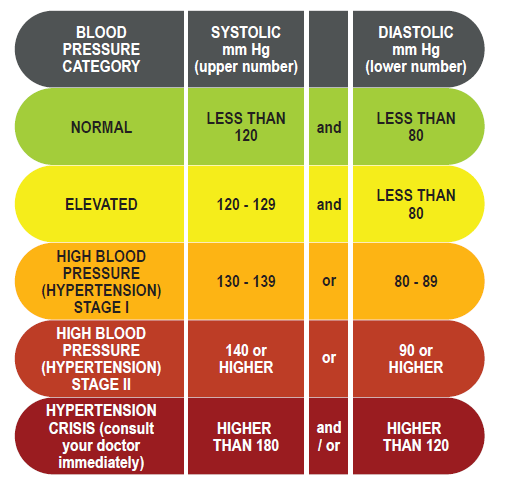Do You Have Hypertension: Know Your Numbers
- Category: Health Education, Primary Care
- Posted On:

Understanding Your Blood Pressure and What You Can Do About It
For most people, high blood pressure lacks the symptoms that get our attention. High blood pressure often comes with no signs or symptoms —but it can quietly put your health at serious risk. So how do we manage it? By focusing on your overall health and educating yourself on blood pressure numbers, you can take steps to manage high blood pressure before it damages your body.
What is High Blood Pressure?
Blood pressure is the force of blood pushing against the walls of your arteries. When that force is consistently too high, you have high blood pressure—also known as hypertension. It’s a common condition, affecting nearly half of Americans over age 20.
A blood pressure reading of 130/80 or higher is considered hypertension. If you see these numbers, it’s time to take action.
Blood pressure is measured with two numbers:
Systolic (top number): pressure when your heart beats
Diastolic (bottom number): pressure when your heart rests between beats
Here’s what your readings mean:

Symptoms? Not So Much.
One of the most dangerous things about high blood pressure is that it usually has no obvious symptoms. That’s why it’s often called the "silent killer." You could be feeling just fine while your arteries are under constant stress.
Untreated, hypertension increases your risk of heart attack, stroke, and other cardiovascular issues.
While there are no tell-tell symptoms of high blood pressures, a few people may experience headaches, shortness of breath, and nosebleeds. These symptoms usually present themselves when high blood pressure has reached a critical stage. If you have these symptoms, along with numbers higher than 130/80, it is time to seek medical care.
Risk Factors to Watch
While an overall healthy lifestyle can help lower your risk factors of hypertension, some things are outside of our control. This is why regular monitoring of blood pressure is important.
The risk of hypertension increases with age and gender – men age 64 and above and women age 65 and above are more likely to develop hypertension. High blood pressure is more common among black people and develop at an earlier age. A family history of high blood pressure increases your risk. Pregnant women also have an increased risk of high blood pressure.
Other risk factors include:
- Smoking or secondhand smoke exposure
- Obesity or being overweight
- Sedentary lifestyle
- A diet high in sodium and alcohol, and low in potassium
- Stress
- Diabetes
- Chronic kidney disease
- Obstructive sleep apnea
Get Checked, Stay Informed
The only way to know where you stand is to get your blood pressure checked regularly. Blood pressure can be checked at your doctor’s office, at some pharmacies, or with a home monitor.
While home monitoring does not replace regular doctor visits or an official diagnosis of hypertension, at home blood pressure monitors can be easily purchased at major retailers, pharmacies, and online. The American Heart Association (AHA) recommends an automatic, cuff-style, upper arm monitor. The AHA does not recommend wrist or finger monitors, as they give a less reliable reading. You should select a blood pressure monitor with a cuff that fits you properly and one that can be validated.
For the most accurate blood pressure reading:
- Sit quietly with your feet flat and back supported.
- Remove clothing over the arm when taking a reading.
- Avoid caffeine, smoking, or exercise for 30 minutes beforehand.
- Rest your arm at chest level.
- Allowing 5 minutes of quiet rest before taking a reading.
- Do not talk, use the phone, or be active when taking a reading.
- Do not cross your legs during a blood pressure reading.
- Measure your blood pressure at the same time every day.
It is important to record your blood pressure readings if you are experiencing high numbers and give those readings to your physicians. Some monitors have a built-in memory to store readings, but recording results are easy. AHA has a printable blood pressure tracker that you can use.
8 Smart Ways to Lower Your Blood Pressure
- Track your readings daily. Use a home monitor and jot them down at the same time each day.
- Move your body. Aim for 150 minutes of activity per week— like brisk walking, dancing, or biking.
- Ditch the cigarettes and vapes. Cigarette, e-cigarette and vape use raises your blood pressure and damages your blood vessels.
- Clean up your plate. Eat a heart-healthy diet—limit salt, skip processed foods, and enjoy fruits and veggies.
- Stay at a healthy weight. Even losing a few pounds can make a difference.
- Manage your stress. Stress management techniques like yoga or deep breathing help.
- Lower your sodium intake and eat foods rich in potassium.
- Limit alcohol consumption.
- Stick to your meds. If your doctor prescribes medication, take it exactly as directed.
- Watch your blood sugar. If you have diabetes, keep your levels in check.
Final Thoughts
Managing blood pressure is a lifelong commitment—but with the right habits, it’s doable and can lead to an overall healthy and happier life. Start small, stay consistent, and don’t do it alone. Your provider can be your best partner in keeping your heart healthy and strong.
🩺 Need a doctor? Find one here.
📚 Want to learn more? Visit the American Heart Association’s Blood Pressure Hub.
Resources:
Mayo Clinic – High blood pressure (hypertension)
American Heart Association – How to Manage High Blood Pressure
American Heart Association – What is High Blood Pressure?




